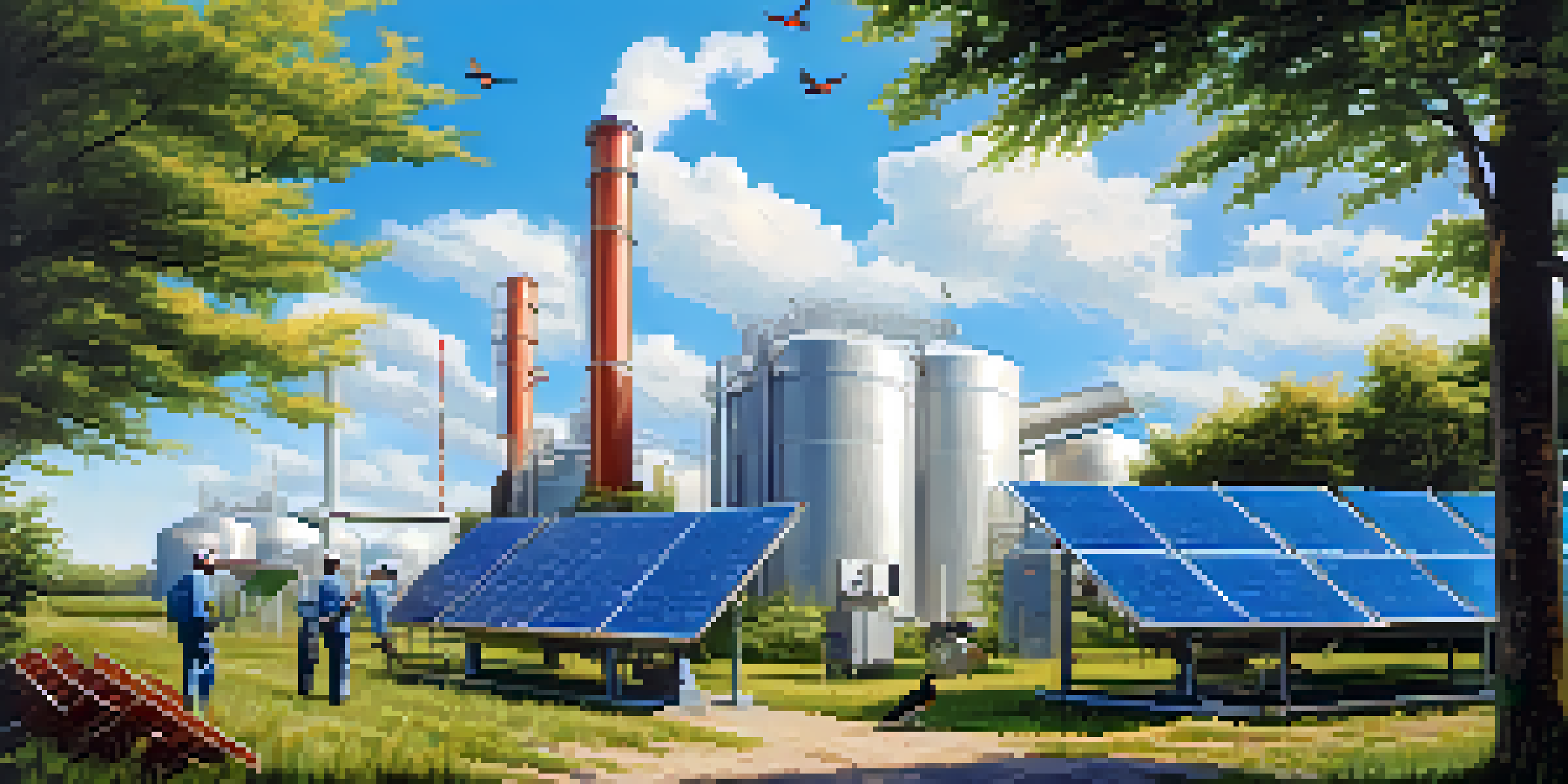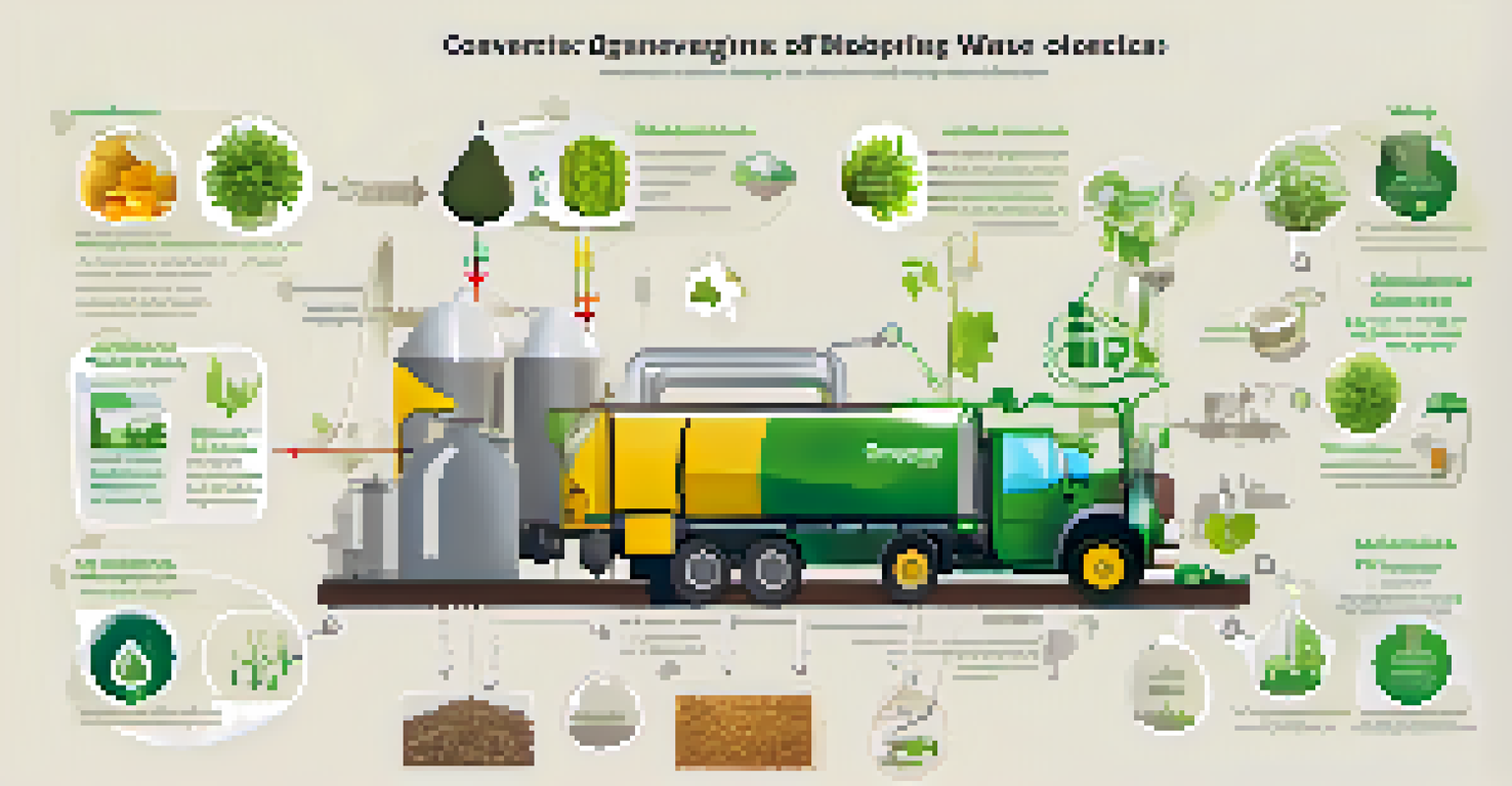How Bioenergy Plants Are Shaping Renewable Energy Landscapes

Understanding Bioenergy: A Green Power Source
Bioenergy refers to energy produced from organic materials, such as plants and waste. It plays a crucial role in the renewable energy sector by converting biological resources into usable energy forms like heat, electricity, and fuels. This process not only provides an alternative energy source but also helps in managing waste effectively.
The greatest threat to our planet is the belief that someone else will save it.
Imagine bioenergy as nature’s recycling system; it takes what would typically end up in landfills and transforms it into something valuable. In turn, this reduces greenhouse gas emissions, making it an eco-friendly option. The versatility of bioenergy, which can be derived from agricultural residues, forestry by-products, or even dedicated energy crops, broadens its impact on the energy landscape.
As we strive for a sustainable future, bioenergy stands out as a practical solution. It not only contributes to energy security but also supports rural economies by creating jobs in biomass production and processing. The ongoing advancements in bioenergy technologies further enhance its efficiency and accessibility, making it a cornerstone of renewable energy.
The Role of Bioenergy Plants in Energy Production
Bioenergy plants are facilities designed to convert organic materials into energy. They play a vital role in the transition from fossil fuels to renewable energy sources. By harnessing the potential of biomass, these plants generate electricity, heat, and biofuels, thereby diversifying the energy mix.

Picture a bioenergy plant as a giant kitchen where waste ingredients are transformed into delicious dishes, fueling homes and industries. This not only meets energy demands but also reduces reliance on non-renewable sources. The integration of bioenergy into the energy grid is a strategic move towards achieving sustainability goals.
Bioenergy Transforms Waste into Energy
Bioenergy effectively converts organic materials, such as waste and agricultural by-products, into usable energy, promoting sustainability and reducing landfill waste.
Moreover, the deployment of bioenergy plants can help stabilize energy prices. By providing a local energy source, they reduce vulnerability to fluctuations in global energy markets. This local production fosters energy independence, ensuring communities have reliable access to energy.
Environmental Benefits of Bioenergy Plants
One of the most significant advantages of bioenergy plants is their positive environmental impact. They contribute to reducing carbon emissions by utilizing organic waste that would otherwise decompose and release greenhouse gases. This process of converting waste into energy is known as carbon neutrality.
We do not inherit the earth from our ancestors; we borrow it from our children.
Think of bioenergy plants as nature’s clean-up crew, taking care of waste while generating energy. They help mitigate landfill use and promote sustainable waste management practices. Additionally, many bioenergy facilities employ advanced technologies to capture emissions, further minimizing their environmental footprint.
Furthermore, when managed sustainably, bioenergy sources can enhance biodiversity. By promoting the growth of energy crops, these plants can create habitats for various species. This dual benefit of energy production and environmental preservation makes bioenergy a compelling option in the renewable energy landscape.
Economic Impact of Bioenergy on Communities
Bioenergy plants play a crucial role in stimulating local economies. By creating jobs in biomass harvesting, processing, and plant operation, they provide new employment opportunities in rural areas. This economic activity can have a ripple effect, benefiting local suppliers and service providers.
Consider the bioenergy plant as a local anchor, providing stability and growth to the community. As these facilities thrive, they often invest back into the community, supporting local initiatives and infrastructure development. This fosters a sense of ownership and pride among residents.
Local Economies Benefit from Bioenergy
Bioenergy plants stimulate local economies by creating jobs and supporting community initiatives, enhancing economic resilience in rural areas.
Additionally, the use of locally sourced biomass reduces transportation costs and emissions, reinforcing the economic viability of bioenergy. Communities can benefit from lower energy costs while contributing to a more resilient and sustainable local economy.
Technological Innovations in Bioenergy Production
Technological advancements are driving the efficiency of bioenergy production. Innovations in biomass conversion technologies, such as anaerobic digestion and gasification, are enhancing the yield of energy from organic materials. These advancements ensure that bioenergy remains a competitive alternative to conventional energy sources.
Think of technology as the engine behind bioenergy plants, optimizing every step of the process from feedstock collection to energy conversion. As research progresses, new methods are developed to improve energy output while reducing costs. This continued innovation is vital for the growth of the bioenergy sector.
Moreover, the integration of digital technologies, like IoT and AI, is revolutionizing the way bioenergy plants operate. These tools can help monitor plant performance, predict maintenance needs, and optimize energy production, ensuring that bioenergy remains efficient and effective in meeting energy demands.
Challenges Facing Bioenergy Plants Today
While bioenergy plants offer numerous benefits, they also face significant challenges. One major concern is the competition for biomass resources between energy production and food supply. This can lead to conflicts over land use, potentially impacting food security.
Imagine a seesaw where bioenergy and food production are balanced; when one side gets too heavy, it can tip the scale. Sustainable management practices are essential to ensure that biomass resources are used responsibly, without compromising agricultural needs. This balance is crucial for the long-term viability of bioenergy.
Technological Advances Drive Efficiency
Innovations in bioenergy production technologies, such as anaerobic digestion and digital monitoring, are enhancing energy output and operational efficiency.
Additionally, public perception and regulatory barriers can hinder the growth of bioenergy projects. Misunderstandings about the environmental impact of bioenergy versus fossil fuels must be addressed. Engaging communities and stakeholders in open discussions about the benefits and challenges of bioenergy is key to fostering support for these initiatives.
The Future of Bioenergy in Renewable Energy Landscapes
The future of bioenergy looks promising as global demand for renewable energy continues to grow. Policymakers are increasingly recognizing the role of bioenergy in achieving climate goals and energy security. With supportive regulations and investment, bioenergy can play a pivotal role in the energy transition.
Envision bioenergy as a growing tree in the renewable energy forest, branching out to support various sectors. As technologies advance and public awareness increases, bioenergy can complement other renewable sources like solar and wind. This synergy will help create a more resilient and diversified energy system.

Ultimately, the success of bioenergy plants will depend on collaboration among governments, industry, and communities. By working together, we can harness the full potential of bioenergy, ensuring it remains a vital component of our sustainable energy future.